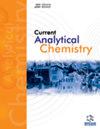评估从加纳槐树皮中提取的改良生物炭对水溶液中 Cr6+ 和 Cu2+ 的解毒潜力:平衡、动力学和热力学研究
IF 1.7
4区 化学
Q3 CHEMISTRY, ANALYTICAL
引用次数: 0
摘要
背景:空气、水、土壤和食物的环境污染已威胁到生态系统中许多动植物群落的持续生存。对 Anonna senegalensis 的化学活化茎皮进行了平衡吸附试验。方法:本研究采用同时批量吸附法,根据 pH 值、溶液温度、起始金属离子浓度、搅拌持续时间、吸附剂剂量、粒度和碳化温度等参数,评估 Annona senegalensis 碳(ASC)对 Cr6+ 和 Cu2+ 的吸附情况。利用得出的平衡吸附数据拟合了伪一阶、伪二阶、颗粒内扩散动力学、Freundlich、Langmuir、Temkin 和 Dubinin-Radushkevich 等温线模型。还对吸附研究的热力学参数进行了评估。结果:ASC 的理化分析表明,灰分含量为 7.21 ± 0.02%,水分含量为 11.73 ± 0.29%,孔隙率为 0.99 ± 0.08,体积密度为 0.18 g/cm3。重金属负载扫描电子显微镜(SEM)显微照片显示出一个填充坑,XRD 衍射图和傅立叶变换红外光谱显示出与原始光谱不同的峰值,这意味着功能化。吸附数据表明,吸附过程的最佳条件为:pH 值为 6,搅拌时间为 88 分钟,吸附剂剂量为 2.5 克/克,初始金属离子浓度为 5 毫克/升,温度为 30°C,粒径为 0.154 毫米,碳化温度为 400°C。结论根据较高的 R2(R2 ≥0.99),发现朗缪尔等温线是所有模型中拟合效果最好的。Dubinin-Radushkevich 证明其机理为物理吸附。伪二阶动力学模型最适合数据,对 Cr6+ 和 Cu2+ 的 R2 分别为 0.998 和 0.986。研究的热力学结果显示,Cr6+ 和 Cu2+ 的 ΔHᵒ 分别为 32.78 和 27.14 KJ/mol,均为正值,这意味着这是一个内热过程,证实了物理吸附机制。熵变 ΔSᵒ 也是正值,表明吸附剂/吸附剂相间存在高度无序性。标准吉布斯自由能 ΔGᵒ 均为负值,显示了自发性和可行性。本文章由计算机程序翻译,如有差异,请以英文原文为准。
Assessment of the Detoxification Potential of Modified Biochar from Annona senegalensis Stem Bark on Cr6+ and Cu2+ in Aqueous Solution: An Equilibrium, Kinetic and Thermodynamic Studies
Background: Environmental contamination of the air, water, soil, and food has become a threat to the continued existence of many plant and animal communities in the ecosystem. The chemically activated stem bark of Anonna senegalensis was examined for equilibrium sorption. Methods: This study aimed to assess the adsorption of Cr6+ and Cu2+ onto Annona senegalensis carbon (ASC) according to the following parameters: pH, solution temperature, starting metal ion concentration, agitation duration, dose of adsorbent, particle size, and carbonization temperature using a simultaneous batch adsorption method. Pseudo-first order, pseudo-second order, intra-particle diffusion kinetic, Freundlich, Langmuir, Temkin, and Dubinin-Radushkevich isotherm models were all fitted using the equilibrium sorption data that were produced. Thermodynamic parameters of the adsorption studies were also evaluated. Results: The physicochemical analysis of ASC showed ash content of 7.21 ± 0.02%, moisture content of 11.73 ± 0.29%, and porosity of 0.99 ± 0.08 with bulk density of 0.18 g/cm3. The heavy metalloaded scanning electron microscope (SEM) micrograph showed a filled pit, and the XRD diffractogram, as well as FTIR spectra, revealed peaks that were different from the raw spectra, implying functionalization. The sorption data gave optimum conditions of the adsorption process to be pH of 6, agitation time of 88 minutes, adsorbent dose of 2.5 g/g, initial metal ion concentration of 5 mg/L, temperature of 30°C, particle size of 0.154 mm and carbonization temperature of 400°C. Conclusion: The Langmuir isotherm was found to give the best-fit conformation of all the models based on superior R2 (R2 ≥0.99). Dubinin-Radushkevich proved the mechanism to be physisorption. The pseudo-second-order kinetic model best fits the data with R2 of 0.998 and 0.986 for Cr6+ and Cu2+. Thermodynamic results of the study revealed that ΔHᵒ for Cr6+ and Cu2+ were 32.78 and 27.14 KJ/mol and are all positive, implying an endothermic process and confirming the physisorption mechanism. The entropy change, ΔSᵒ, was also positive, revealing a high degree of disorderliness at the sorbate/sorbent interphase. The standard Gibbs free energy, ΔGᵒ, were all negative, showing spontaneity and feasibility.
求助全文
通过发布文献求助,成功后即可免费获取论文全文。
去求助
来源期刊

Current Analytical Chemistry
化学-分析化学
CiteScore
4.10
自引率
0.00%
发文量
90
审稿时长
9 months
期刊介绍:
Current Analytical Chemistry publishes full-length/mini reviews and original research articles on the most recent advances in analytical chemistry. All aspects of the field are represented, including analytical methodology, techniques, and instrumentation in both fundamental and applied research topics of interest to the broad readership of the journal. Current Analytical Chemistry strives to serve as an authoritative source of information in analytical chemistry and in related applications such as biochemical analysis, pharmaceutical research, quantitative biological imaging, novel sensors, and nanotechnology.
 求助内容:
求助内容: 应助结果提醒方式:
应助结果提醒方式:


